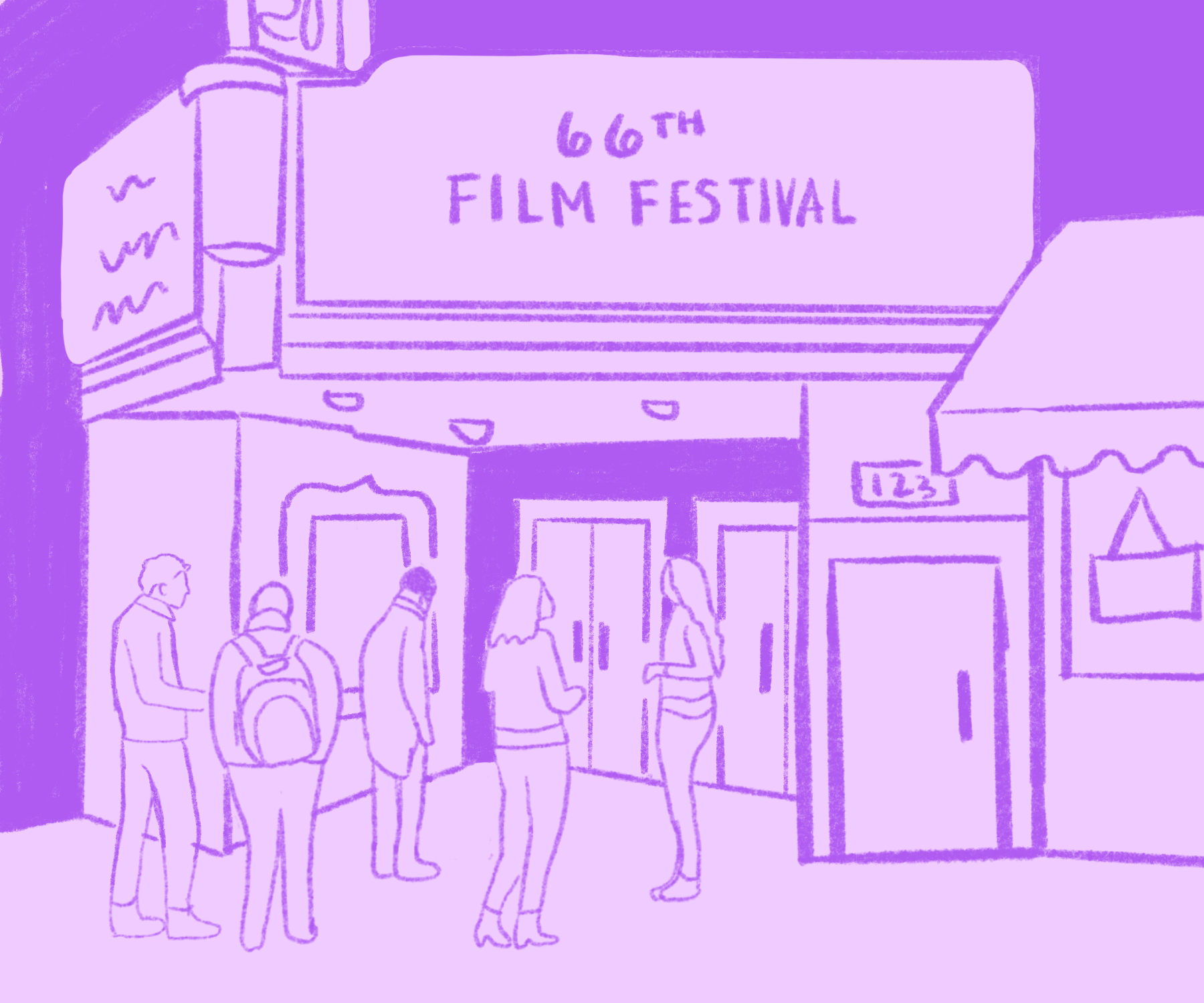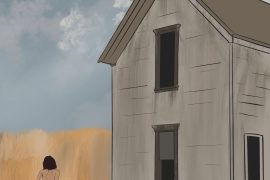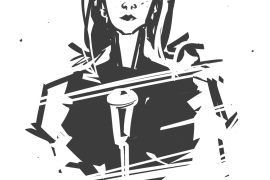The Flaherty Film Seminar is an annual film seminar that features documentary, narrative, and experimental films from around the world. The seminar began in 1955 as an informal convention of filmmakers, critics, and enthusiasts that has blossomed into one of the premier film seminars for industry professionals. While the event, having just completed its 66th edition, bears resemblance to a traditional film festival, it offers a unique method of participation for its featured artists and attendees. The programming of the seminar is conducted without foreknowledge of the featured films or filmmakers. Nestling into their seats, attendees are unaware of what they will see, how many films, which genres, which themes, languages, or nations of origin. This approach to programming, made complete by the lack of competing screenings, ensures that attendees approach the featured films without prejudice related to content. The result is a more egalitarian film event during which one may unknowingly mingle with the featured filmmakers at any point. Screenings are followed by rich discussion between featured artists and attendees with questions ranging between the technical, artistic, and critical. Through these discussions, filmmakers and critics expand their understanding of film as it exists interculturally, leading to fantastic collaboration and exchange of techniques and approaches to the medium.
Each year, the Flaherty Film Seminar selects a theme that links the featured films and is intended to guide discussion. The theme of the 66th Flaherty Film Seminar was opacity. The seminar describes opacity as the sensation of fragmentation and uncertainty, and encouraged attendees to “look defiantly at the opaque places of cinema.” The nature of opacity was two fold, at once encouraging exploration of the unknown and opaque while simultaneously supporting the philosophical right to opacity proposed by Édouard Glissant. The seminar created a space in which barriers to understanding were free to be broken or upheld as the individual saw fit.
Programmed by Janaína Oliveira, a film scholar focused on Black and African film, the 2021 Flaherty Film Seminar prominently featured Black and African filmmakers, namely concentrating on the Sudanese Film Group, as well as Indigenous and non Indigenous films from her nation of origin, Brazil. The result of these programming decisions was to highlight films that have had little impact in North America despite sometimes tremendous influence in other parts of the world. The intersection between the Sudanese Film Group and the former Soviet Union and East Germany, for example, was a particularly enlightening look at the opaque history of both regions, often obscured as they are by propagandist narratives.
The 66th Flaherty Film Seminar was a dizzying event taking place over the course of ten days. While the virtual nature of the seminar due to the ongoing pandemic certainly curtailed the social elements of the event, it remained true to its cause of bringing moving films into a new light. Below you’ll read my personal selections for outstanding films featured at the seminar. Each one comes with its own unique vision and impact, some of which will be discussed. I highly encourage readers to seek these films for screening and have included ways to find more information on each film, including screening times, trailers, and streaming access when available.

illustrations by Alison White
Day Two Highlights
Day two of the 2021 Flaherty Film Seminar stands out as one of the strongest of the seminar, both on narrative and experimental fronts. My two picks for highlights from the day are “In Vitro” (2019), a 28 minute, Arabic language short film by Palestinian-Danish filmmaking team Larissa Sansour and Søren Lind and “Vaga Carne” (2019) by Grace Passô. “In Vitro” takes place in a post-apocalyptic Bethlehem, wherein an abandoned underground nuclear reactor has been converted to an orchard in an attempt to preserve humanity. The film revolves around a visit between ailing Alia, a founder of the orchard, and her young clone who struggles to take ownership of the memories implanted within her. The film expertly utilises a two channel approach to narrative, whereby there is an ever present bifurcation of the viewing experience. This approach seamlessly blends with the narrative’s themes of perspective, memory, and nostalgia to create a dizzying spectacle that rewards multiple viewings without exhausting the spectator. The character driven story provides a poignant reflection on identity while the staging of Palestinian exile and survival within Bethlehem makes for a noticeable political statement.
A preview of “In Vitro” is available at larissasansour.com/In-Vitro-2019
“Vaga Carne” (2019), written by Grace Passô and directed by Ricardo Alves Jr. and Grace Passô, is a Brazilian experimental spoken word piece set to film. The piece follows a wandering voice that can possess any form. During the film, the voice possesses a woman’s body and narrates the sensations swirling about it, breaking down the body as a social construct while also illuminating the societal construction of womanhood. Exquisitely acted by Grace Passô, the voice scathes and raves in an entrancing performance for the entire 45 minute runtime. “Vaga Carne” stands as one of the most compelling film experiments of the 2021 Flaherty Film Seminar and will certainly make for a memorable viewing even for those normally disinterested in experimental film.
A trailer for “Vaga Carne” is available at https://embaubafilmes.com.br/locadora/vaga-carne/
Day Three Highlights:
“NŨHŨ YÃG MŨ YÕG HÃM: ESSA TERRA É NOSSA!” (2020) is a Brazilian documentary feature film written by Sueli Maxakali and directed by Carolina Canguçu, Isael Maxakali, and Sueli Maxakali. The film explores the struggle for Indigenous land rights in Brazil, the storied history of the Maxakali, and some of their cultural practices. The film is foremost about the impacts of colonization on the Maxakali people, their environment, and their ways of life, as well as their contemporary struggles in a Brazil that is increasingly hostile to its Indigenous peoples. The documentary has a magnificent transportational effect that allows viewers to transcend national and cultural boundaries to truly sympathize with the plight of those featured, recognize one’s own role as a colonizer when applicable, and to internalize the lessons learned and apply them in daily life. The documentary is primarily presented in an observational mode, but thankfully lacks the anthropological gaze of the colonizer through its virtue as an internally produced Maxakali film.
Day Four Highlights:
“Jamal” (1981) is a short film by Ibrahim Shaddad, a founding member of the Sudanese Film Group, and stands out as a highlight of the entire Flaherty Film Seminar. The film portrays the life of a camel put to work in a sesame mill. With that simple premise, Shaddad crafts a psychologically intriguing transportation to the camel’s perspective. The soundscape of the film is key to its haunting quality, as the grinding of the sesame mill blends with the struggling cries of the camel. Insert shots cue the viewer to reassess their relationship to other species and the ways in which human beings are often diminished to their working capital. The film creates a longing for and appreciation of one’s freedoms and luxuries as a human being, compared to the all suffering beast of burden. “Jamal” is as much an essay on the human condition as it is an exploration of the camel’s lot in life.
“Jamal” is available on DVD at https://www.arsenal-berlin.de/en/edition/dvds/sudanese-film-group.html
“The Paul Good Papers at Notasulga” (2012) by Deanna Bowen expands the 2021 Flaherty Film Seminar into an interdisciplinary mode by gathering articles, photographs, and other resources, including an imageless video with accompanying audio recorded by Paul Good while covering the integration of schools in Notasulga, AL. The project highlights the role of the Ku Klux Klan in opposing school integration and the beating of photojournalist Vernon Merritt III. The project frames itself with the connections between Klan activity in the United States and contemporary issues in Canada. The piece is provocative in its use of documentary audio to connect the recent past with the present of racism in North America. While not what we have been conditioned to understand as a film, “The Paul Good Papers at Notasulga” delivers a poignant experience that is not to be missed.
The film version of “The Paul Good Papers at Notasulga” is available for viewing on YouTube at https://www.youtube.com/watch?v=O3SIsxjcAqw
The exhibit “The Paul Good Papers” is elaborated through photographs at http://www.deannabowen.ca/the-paul-good-papers/
Day Five Highlights:
“Paradise Omeros” (2002) by Isaac Julien truly fits with the theme of opacity, as the film explores Creole identity through the contrast of 1960s England and the Saint Lucia of today. The film’s dreamlike narrative tests the construction of postcolonial identity while steeped in the intercultural longing for place, torn between multiple identities. “Paradise Omeros” transports the audience through the experience of displacement often felt by those who are members of any particular diaspora and blends those sensations with the specific linguistic and cultural contexts of England and Saint Lucia. The result is a disorienting film that requires the bilingual viewer to frequently code switch and the monoglot to dither between relative comfort and otherness. “Paradise Omeros” does an excellent job of communicating its cultural context through audience transportation, imparting for the viewer a sense of camaraderie with the protagonist that lingers long after the screening has ended.
A trailer for “Paradise Omeros” is available at https://vimeo.com/529930680
Day Six Highlights:
“Africa, Dzungli, Baraban I Revolucija” (1979) is an 11 minute documentary directed by Suliman Elnour of the Sudanese Film Group. The film explores representations and stereotypes of Africa held by the people of the Soviet Union. Through on the street interview footage and archival stock of African locales, “Africa, Dzungli, Baraban I Revolucija” portrays the hopeful relationship between the Soviet Union and decolonizing nations in Africa, complete with its many oversimplifications and misrepresentations. The film provides a rare glimpse at this relationship too often relegated to conversations about Soviet expansionism and colonialism. This documentary provides a unique dual glance at the often misunderstood Soviet Union and African continent from the perspective of a Sudanese student in Moscow, a perspective that is never lost, but rather adopted through the screening.
“Africa, Dzungli, Baraban I Revolucia” is available on DVD at https://www.arsenal-berlin.de/en/edition/dvds/sudanese-film-group.html
Day Seven Highlights:
Day seven featured another film by Sueli Maxakali, “YÃY TU NUNÃHÃ PAYEXOP: Encontro de Pajés” (2021), which depicts a Maxakali ritual to protect against the coronavirus. The film explores the impact of the coronavirus on Indigenous peoples in Brazil as viewed through the Maxakali lens. Though COVID-19 had not yet dramatically impacted this group, the film explores the precautions being taken and the limitations of Indigenous peoples to respond to the threat of the pandemic. “YÃY TU NUNÃHÃ PAYEXOP: Encontro de Pajés” excellently details the gap between the most and least privileged during the pandemic and encourages greater understanding and empathy for those denied the advantages of life in the wealthiest nations on Earth.
“YÃY TU NUNÃHÃ PAYEXOP: Encontro de Pajés” can be screened on YouTube with Portuguese subtitles at https://www.youtube.com/watch?v=17I7DluYbqs
Day Eight Highlights:
One of the highlights of day eight of the Flaherty Film Seminar was an artist talk by Deanna Bowen, during which she walked the audience through slideshow versions of her exhibits “Black Drones in the Hive” and “The God of Gods: Berlin, Berlin.” “Black Drones in the Hive” is an exhibit created to coincide with the centenary of the first showing of Canada’s “Group of Seven” a club of landscape painters who are upheld in Canadian society as the architects of the colonial nation’s artistic heritage. These painters, however, excluded from their work scenes of Indigenous people, the enduring Indigenous artistic heritage of the region known as Canada, as well as the Black population of Canada. The result was the creation of a Canadian artistic tradition that is inherently white supremacist and exclusive, reflecting the beliefs and prejudices of the painters. By portraying the history of Black Canadians in contrast with this painting tradition, Deanna Bowen turns a century of erasure into a spotlight on Canadian racism. “Black Drones in the Hive” is a permanent installation at the Kitchener Waterloo Art Gallery in Kitchener, Ontario, Canada.
“The God of Gods: Berlin, Berlin” was an exhibit that reflected on the history of Kitchener, Ontario, Canada, previously known as Berlin, as well as its connections to Berlin, Germany. The exhibit contextualizes the relationships between Canada, the British Commonwealth, the United States, Germany, and Africa until the Great War.
Images from Deanna Bowen’s galleries can be found at http://www.deannabowen.ca/
Day Nine Highlights:
“Nation Estate” (2012) is another entry by Palestinian-Danish filmmaking team Larissa Sansour and Søren Lind. Focusing on the dream of Palestinian nation building during a time when the Palestinian population is rapidly declining, “Nation Estate” takes place within a single massive building that houses the entire future of Palestine. In the film, we catch glimpses of the land over which Palestinians are in conflict today recreated within the Nation Estate. The film fills the role of a thought experiment both for vertical nationhood, which has appeared in science fiction mostly in the context of space travel, as well as a cry of mourning for the increasing devastation of the Palestinian population and culture. “Nation Estate” asks the questions, “How do Palestinians survive their displacement?” and “What will it take for Palestinian nationhood to no longer be defined by conflict?” All the while, the representation of recreations of important landmarks for Palestinians portrays a grim proposition, that the quagmire over Palestine will only ever amount to an illusion of nationality.
“Nation Estate” can be viewed in full at https://vimeo.com/47817604
Day Ten Highlights:
Day ten’s highlight is an additional contribution by Larissa Sansour and Søren Lind, “In the Future They Ate from the Finest Porcelain” (2016). “In the Future They Ate from the Finest Porcelain” portrays the confession of a narrative terrorist, a woman who plants evidence to alter the archaeological record of an unnamed culture, presumed to be Palestine. The film is a visually stunning reflection on diaspora and the ever present threat of extinguishment that threatened cultures, including Palestine, face. By planting porcelain in the archaeological record, this narrative terrorist aims to allow future generations to assert claims to their ancestral land, other evidence of which has been destroyed. The 29 minute long film reckons with ancestral loss and what that means for one’s place in the world. It ponders a future in which the unnamed culture persists only in its dislocation, connecting with themes prevalent in Sansour and Lind’s other works.
A trailer for “In the Future They Ate from the Finest Porcelain” is available at https://vimeo.com/148158228






